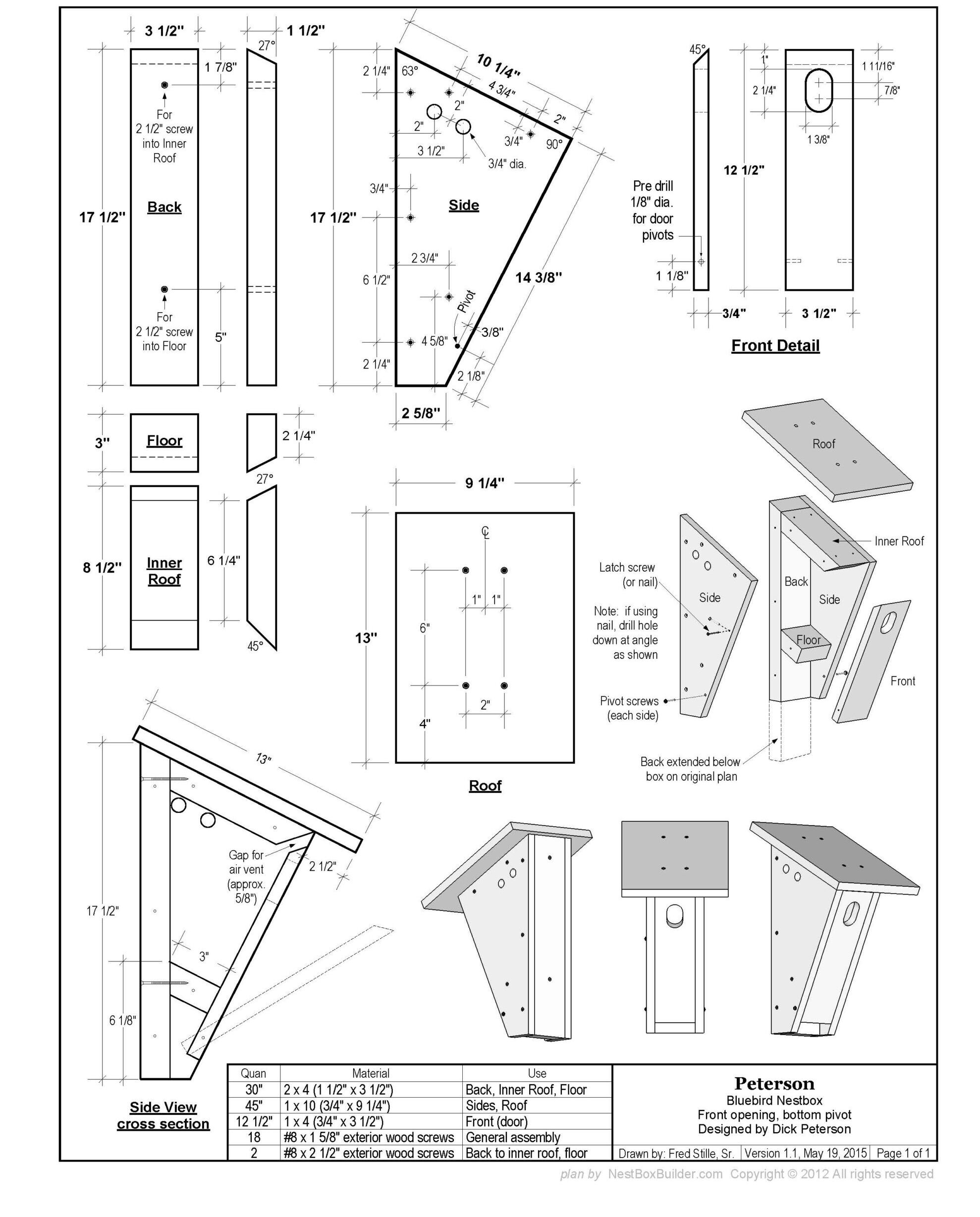The Basics of Bird Boxes
Bird boxes are becoming increasingly common in rural and urban areas, but are they really helping our feathered friends? For the best outcomes, follow these guidelines when building or installing bird boxes.
Why Put Up Bird Boxes?
Bird boxes, also called nesting boxes or birdhouses, can be installed in areas where there is a lack of trees large enough for birds to create cavities in their trunks. The loss of these large trees is often a limiting factor for certain bird species, even if the surrounding habitat meets their feeding needs.
In nature, woodpeckers are primary cavity makers. Birds such as chickadees and swallows are secondary cavity users, meaning they use old woodpecker holes or natural tree cavities where rotten limbs have fallen off.
Bluebird Boxes
Bluebird boxes were some of the first nesting boxes made on a wide scale in response to the alarming decline of Eastern Bluebird populations in the 1990s.
Bluebirds feed on insects in open areas near farmland, but the lack of large trees was seen as a weak link in their survival. Other threats included habitat loss and nesting competition from more aggressive, introduced species such as House Sparrows and European Starlings.
In areas where dead trees and woodpecker holes are hard to find, bluebirds will readily move into nesting boxes to raise their young. A movement was started and nesting boxes were installed to help increase the population of this charismatic songbird, resulting in positive outcomes.
Following the success of this movement, other bird box designs quickly followed.
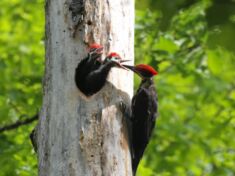
Woodpeckers such as this Pileated, make their own cavity nests in trees. Photo by Sean Brown.
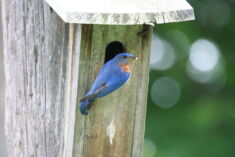
A Bluebird perches at the entrance to a bird box. Photo by Brenda Gallagher.
Building Your Bird Box
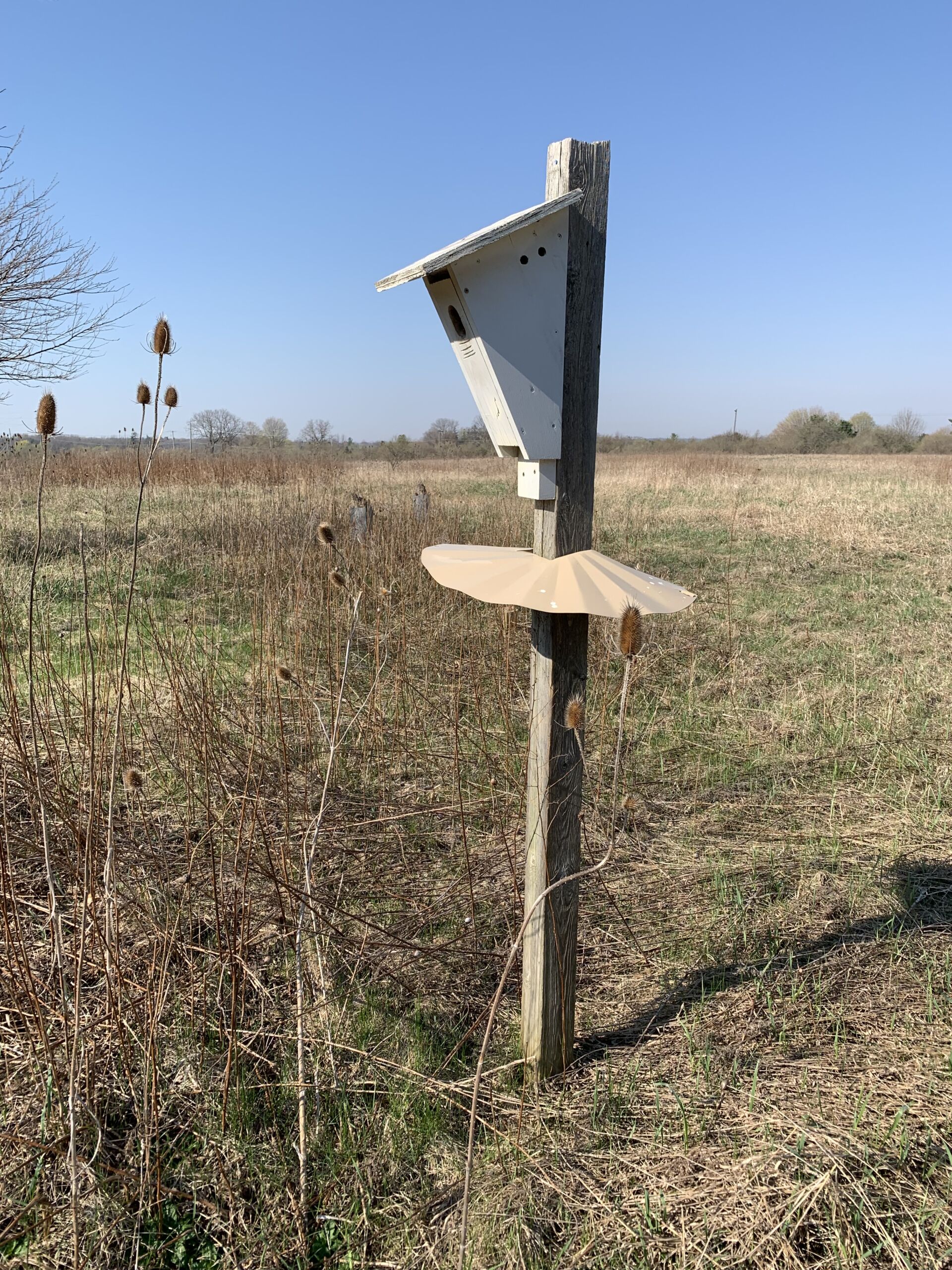
The Right Box for the Right Bird
There are many bird box designs for a wide range of cavity nesting birds. The basic design is the same for most birds, but the dimensions of the box and entrance hole vary according to the species you are hoping to attract. See the Nesting Box Dimensions table below or go to nestwatch.org for more information on bird box specifications.
Construction Materials and Design Features
Use untreated, unpainted wood and galvanized screws that will not rust. The outside of the box may be painted white after it is constructed to reflect light and keep the box cooler in sunny locations.
To keep birds dry, nesting boxes generally feature a sloped roof that overhangs the front, a recessed floor (6 mm up from the bottom), and drainage holes. The roof overhang also deters predators from reaching in from the top.
Ventilation holes are drilled near the top of the side panels for air movement. The front or side panel/wall should be hinged with a latch to provide access for cleaning.
Keep Predators Out
Common nesting box predators include raccoons, chipmunks, cats, and sometimes snakes. To limit predators:
- do not add a perch,
- use a metal pole to mount the box,
- add a predator guard or baffle, and
- never install bird boxes on fence posts or trees.
Nesting boxes with predator guards have a higher success rate than those without guards. Several designs are available such as a metal collar, a stovepipe baffle (pictured below), or Noel Guard.
Metal poles are more easily equipped with guards than wooden posts. Get construction plans for building predator guards at nestwatch.org.
A bird box with a stovepipe baffle.
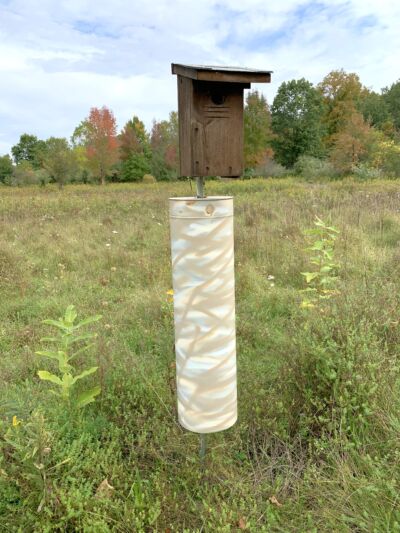
A Bluebird box with a metal collar.
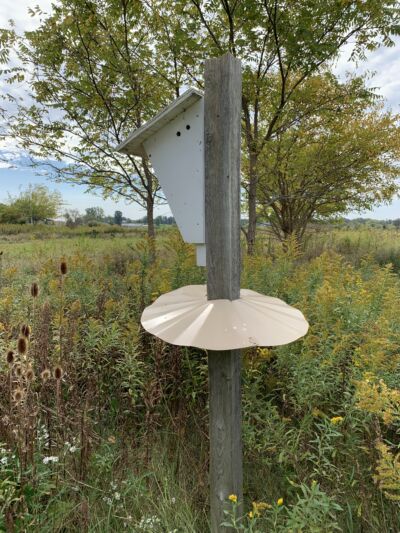
Locating Your Bird Box
The vegetation surrounding your bird box will play a role in determining which species it will attract. Different species prefer different kinds of habitat. In general, good locations include sites:
- that have been recently planted with trees as part of reforestation efforts,
- in or near meadows and thickets, and
- in or near unsprayed hay fields and pastures.
Bird boxes may not be advised in urban areas because non-native House Sparrows and European Starlings may move in. House Sparrows can fit through holes 3.1 cm (1-1/4 inch) in diameter and Starlings can squeeze through 3.9 cm (1-9/16 inch) openings.
Avoid areas where pesticides are used (e.g., golf courses and cultivated farm fields) as these chemicals are harmful to birds and their insect prey. Avoid placing boxes next to busy trails and roads. Boxes should be at least 2-3 m away from bird baths and feeders.
Box Placement
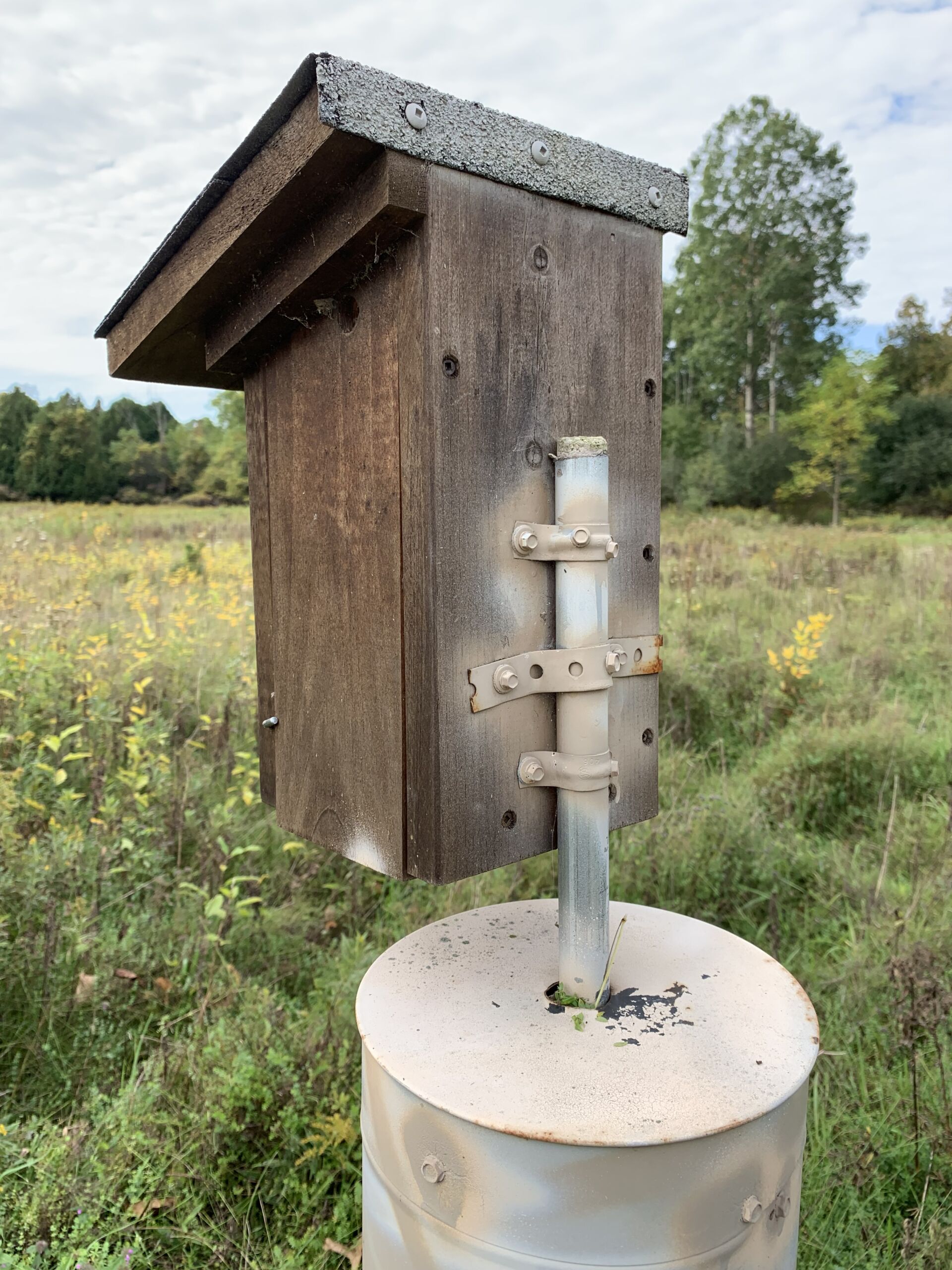 Spacing: Birds are territorial, so providing some space will help them feel more comfortable. In general, install no more than 10 boxes per hectare (4 boxes/acre) and space them at least 8 m apart. That said, there are exceptions. For Eastern Bluebirds, the rule of thumb is 2.5 boxes per hectare (1 box /acre). Tree Swallows nest in colonies so bird box spacing can be closer. See the table below for more details.
Spacing: Birds are territorial, so providing some space will help them feel more comfortable. In general, install no more than 10 boxes per hectare (4 boxes/acre) and space them at least 8 m apart. That said, there are exceptions. For Eastern Bluebirds, the rule of thumb is 2.5 boxes per hectare (1 box /acre). Tree Swallows nest in colonies so bird box spacing can be closer. See the table below for more details.
Height: Install the boxes at least 2 m (6.5 ft.) from the ground to dissuade predators, but low enough to allow access for cleaning. Some species require their boxes on taller poles (see table below).
Poles: The best way to put up small nesting boxes is on free-standing metal poles (e.g., gas pipes) or PVC pipes that are easily driven into the ground. Smear grease on the poles so predators cannot climb them. Predator guards are advised for all boxes, especially if using a wooden pole, as predators find these easier to climb.
Attaching boxes to poles: For metal poles, attach the box to the pole with clamps secured to the back (see picture). Ensure the tips of the screws are not exposed on the inside of the box where they may harm nestlings. Alternatively, a pipe flange fastened to the bottom of the box can be used to screw the box to the top of a pole. The back panel of the box can be cut longer than the sides to make it easier to mount on a pole or post.
Orientation: Generally, the opening of the bird box should face east to catch the early light, but avoid the noon day sun. Also, an easterly orientation provides protection from the prevailing westerly winds.
| Species | Hole Diameter (cm) | Box Height (m) | Minimum Spacing (m) | Boxes/Ha |
|---|---|---|---|---|
| American Kestrel, Screech Owl | 7.5 | 4.5 | 800 (kestral) | |
| Black-capped Chickadee, Downy Woodpecker, White-breasted Nuthatch | 3.0 | 2.0 | 200 (chickadee), 317 (nuthatch) | |
| Eastern Bluebird | 4.0 | 2.0 | 90 | 2 |
| Great Crested Flycatcher | 4.0 | 1 | ||
| Hairy Woodpecker | 5.0 | 3.0 | ||
| House Wren | 2.5 | 2.0 | 30 | |
| Northern Flicker | 6.5 | 3.0 | 30 | |
| Purple Martin | 5.0 | 2.5 | 3 | |
| Tree Swallow | 4.0 | 2.0 | ||
| Wood Duck | 7.5 | 2.5 | 182 |
Upkeep
Cleaning: A buildup of waste and nest material is unattractive to birds, so annual cleaning in the early spring or late autumn is advised. Bird boxes are designed with a hinged side so they can be opened up to provide access for cleaning and monitoring. A latch or nail keeps the box securely closed until you are ready to open it.
Repairs: If squirrels chew at the entrance, secure a piece of sheet metal around the hole. (See photo on right).
Other nesters: Mice may move into bird boxes in the winter. If you wish to avoid mouse nests and non-native bird species, leave the box open over winter and close it as soon as the native birds return in the spring. Native bees may also find a bird box attractive for nesting, so use caution when opening a box. Never use pesticides to evict bees as the chemical may harm future birds.
Note: Improper nesting boxes do more harm than good. Remove them is you are not prepared to manage them properly.
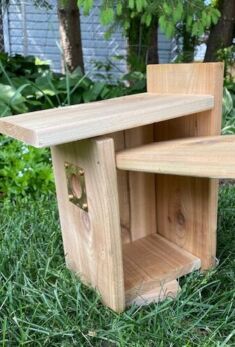
A bird box with sheet metal around the entrance.
| Helpful Links | Bird Box Plans |
|---|---|
Peterson Bluebird Nestbox Design by Dick Peterson:
